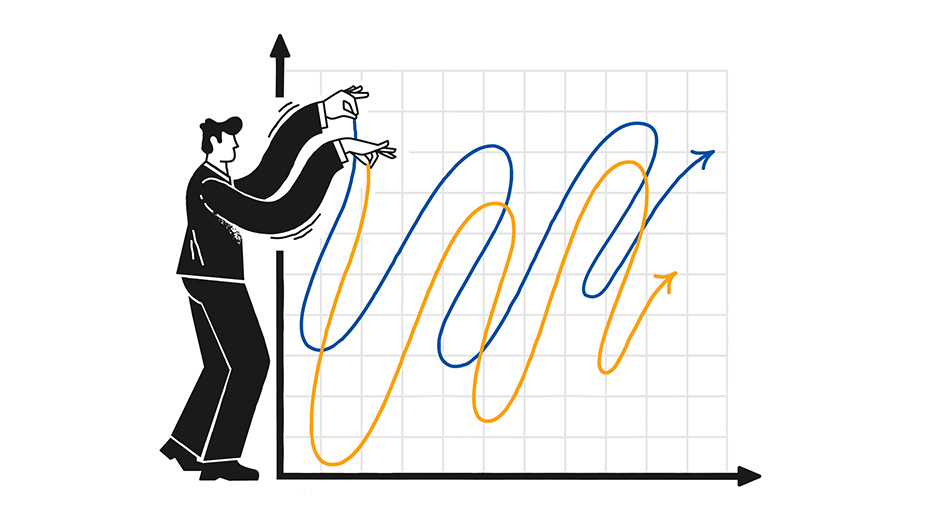Why Order Types Matter During Market Volatility
Written by The Inspired Investor Team
Published on May 16, 2025
minute read
Share:
Global stock markets have been on a wild ride ever since the U.S. unveiled a series of reciprocal tariffs that hit almost every country – including its biggest trading partners – and this has left many investors feeling anxious. At times like this, it’s natural to look for ways to regain control of your portfolio. Making small tweaks to the way you place trades could give you greater control over the prices you accept when buying and selling stocks, no matter what the markets are doing.
Market vs. limit orders
A market order can be beneficial if you want to buy or sell immediately at the best prices available, while limit orders allow you to set parameters for price and time. Market orders prioritize speed of execution, while limit orders prioritize price to help investors avoid unexpected transactions in volatile or thinly traded markets.
Some traders prefer market orders for stable, frequently traded stocks – also described as securities with more liquidity – where price changes aren’t a major concern. Limit orders tend to be more useful for stocks experiencing greater volatility and/or less liquidity.
When you buy or sell a stock and place a market order, your trade will be executed at the best available ask prices if you are buying, and the best available bid prices if you are selling. Electronic systems, and in some cases professional traders that work at the brokerage’s trading desk, attempt to fill market orders quickly to avoid price slippage, but because prices can change from moment to moment, the final price for a stock could be higher or lower than what you might have expected.
For example, let’s say the stock of XYZ Corp. is trading a bid of $49.95 and an ask of $50. If you place a market order to buy, you’ll likely pay $50 – paying the spread (or difference) of $0.05 to complete the trade quickly and efficiently before potentially big shifts take place.
When there’s volatility, the price of stocks are changing rapidly and there is a higher chance that your trade will be executed at a different price than what you may have expected. During these times you may want to consider placing a limit order. A limit order allows you to control the maximum price you’re willing to pay when buying a stock or the minimum price you want to sell it for. If you’re buying using this type of order, your trade will only execute if the share price is at or below the price you set. Likewise, when you’re selling, orders will only be completed if the price is at or higher than the one you set.
If you decide to change your limit price or time frame, you can modify your order on the Order Status page, if it hasn’t already been filled.
Limit order examples:
Buying: Say you want to buy shares of ABC Inc., which last traded at $100, but prefer to purchase it at a lower price and you’re not in a rush. A limit order would allow you to set the maximum price you're willing to pay – say $90 – and choose a cut-off date (also known as a good through date) up to 90 days in the future. If the price doesn’t hit that number by the time specified, the order expires.
Selling: Say you bought shares of ABC Inc. for $90 and want to sell when it reaches $110. You set your limit price at $110 and choose your “good through” date, meaning that if ABC rises to $110 or more within that timeframe, your order will be filled if there are enough willing buyers at the other end of the transaction.
|
When you go to buy or sell a stock, you’ll typically see a quoted price – often labelled as the “last price.” While this tells you the price of the most recent trade, it’s not necessarily the price your order will be filled at. The reason for this is because every stock trade involves two sides: a buyer and a seller. The best bid is the highest price someone is currently willing to pay for a stock and the best ask is the lowest price someone is willing to sell it for. The difference between these two prices is called the bid-ask spread. Marketplaces use order books – electronic lists of buy and sell orders organized by price, broker and time – to match up trades. People and systems are constantly working to pair up willing buyers and sellers to find the best prices. RBC Direct Investing offers clients a Level 21 order book on the Detailed Quote page, so you can see the bids and asks for many securities made in real time. |
Stop-orders
Stop orders, sometimes referred to as stop-loss orders, share similarities with both limit and market orders. Like a limit order, you can place an order to buy or sell a security once it reaches a specified price, known as the stop price. The key difference, though, is that once the share price meets your set stop price, it will be triggered and executed like a market order, buying or selling at the best available price.
For a sell stop order, that means your order could get filled at the stop price or below. If the price is falling rapidly, there is a chance the actual sale price could be significantly below your stop price. For a buy stop order, that means you could get filled at the stop price or above. If the price rises rapidly, there is a chance the purchase price could be significantly above your stop price.
For instance, let’s say you bought a stock at $40 and wish to limit your potential loss. You place a sell stop order with a stop price of $36 (10% lower than the price you bought it at), valid for a certain number of days. At the end of the day, the stock closes at $39. But, the next morning, the stock trades at $35 at the opening bell. Your stop order is triggered and your shares are sold at $35 which is $1 below your set stop price of $36.
That said, stop orders can help remove some of the emotions that come with seeing stocks decline and can lessen the pressure to constantly monitor your portfolio, since they trigger automatically. Selling shares this way may help limit additional loss one would have if the price continued to fall, though it could also exaggerate the loss in a fast moving market. To avoid the risk of a stop order executing at an unexpected price, one might consider placing a stop-limit order.
Stop-limit Orders
Stop-limit orders are similar to stop orders but give you more control over the execution price. Like a stop order, it is only triggered when the stock reaches your specified stop price - the key difference is that when you place a stop-limit order, you set two prices: The stop price which triggers the order, and the limit price, which sets the minimum (for sell) and maximum (for buys) you’re willing to accept. Once the stop price is reached, the order is triggered and will attempt to execute at the limit price or better.
But if the stock price drops quickly below both your stop and limit prices during the day, or if the stock opens the next day below your limit, your order may not be executed. In this case, your order will remain open and you will hold on to your shares until it gets filled or expires.
For example, let’s say a stock is trading at $50 and you want to sell if the price starts to drop – but only if it remains above a certain price. You set a stop-limit order with a stop price of $48 and a limit price of $47. That creates a $1 band. If the stock falls to $48, the order is triggered and becomes a limit order. It will attempt to sell your shares – but only if the price stays $47 or higher. If the stock plummets quickly and skips past your limit, say to $46.50, the order won’t fill. You’ve avoided selling below you desired price, but at the cost of holding onto your shares at a lower value.
You can also use a stop-limit order to buy. A stop-limit buy order is useful if you want to buy a stock only after it rises to a certain price – but you don’t want to pay more than a specific amount.
Let’s say a stock is trading at $50 and you believe a breakout past $52 could signal further gains. You might place a stop-limit buy order with a stop price of $52 and a limit price on $53. If the stock hits $52 the order will trigger, and attempt to buy the stock. If the price jumps straight to $54, your order won’t be filled.
|
You can choose your order type on the RBC Direct Investing online platform, the RBC Mobile2 app, and the Trading Dashboard. Here’s how to choose your order type on RBC’s online platform and on the mobile app: 1. Select Buy or Sell on a Detailed Quote for a stock or ETF to open the order form 2. Once the order form is open you can choose which order type you would like to use (market, limit, stop limit, or stop order (not available in Canadian markets). 3. Enter the quantity or estimated value of shares. 4. Click “Continue” and review your order. If everything is correct, click "Place Order." A trade confirmation message will appear. |
RBC Direct Investing Inc. and Royal Bank of Canada are separate corporate entities which are affiliated. RBC Direct Investing Inc. is a wholly owned subsidiary of Royal Bank of Canada and is a Member of the Canadian Investment Regulatory Organization and the Canadian Investor Protection Fund. Royal Bank of Canada and certain of its issuers are related to RBC Direct Investing Inc. RBC Direct Investing Inc. does not provide investment advice or recommendations regarding the purchase or sale of any securities. Investors are responsible for their own investment decisions. RBC Direct Investing is a business name used by RBC Direct Investing Inc. ® / ™ Trademark(s) of Royal Bank of Canada. RBC and Royal Bank are registered trademarks of Royal Bank of Canada. Used under licence.
© Royal Bank of Canada 2025.
1 Level 2 quotes are available on stocks and ETFs that trade on the TSX and TSX-Venture exchanges for all clients. Level 2 quotes are also available on stocks and ETFs that trade on the Canadian Securities Exchange and Nasdaq for Active Trader clients upon accepting the terms and conditions of all exchange agreements on the RBC Direct Investing online investing site.
2 RBC Mobile is operated by Royal Bank of Canada, RBC Direct Investing Inc. and RBC Dominion Securities Inc.
Any information, opinions or views provided in this document, including hyperlinks to the RBC Direct Investing Inc. website or the websites of its affiliates or third parties, are for your general information only, and are not intended to provide legal, investment, financial, accounting, tax or other professional advice. While information presented is believed to be factual and current, its accuracy is not guaranteed and it should not be regarded as a complete analysis of the subjects discussed. All expressions of opinion reflect the judgment of the author(s) as of the date of publication and are subject to change. No endorsement of any third parties or their advice, opinions, information, products or services is expressly given or implied by RBC Direct Investing Inc. or its affiliates. You should consult with your advisor before taking any action based upon the information contained in this document.
Furthermore, the products, services and securities referred to in this publication are only available in Canada and other jurisdictions where they may be legally offered for sale. Information available on the RBC Direct Investing website is intended for access by residents of Canada only, and should not be accessed from any jurisdiction outside Canada.
Explore More

5 Ways to Get More Out of Your RESP
How can you make the most of this investment vehicle? We explain.
minute read

There's an ETF for That!
Find out more about the options that are out there
minute read

ETF Trends from the RBC Capital Markets Trading Floor – May 2025
Here’s what we saw on the trading floor in May 2025
minute read
Inspired Investor brings you personal stories, timely information and expert insights to empower your investment decisions. Visit About Us to find out more.







